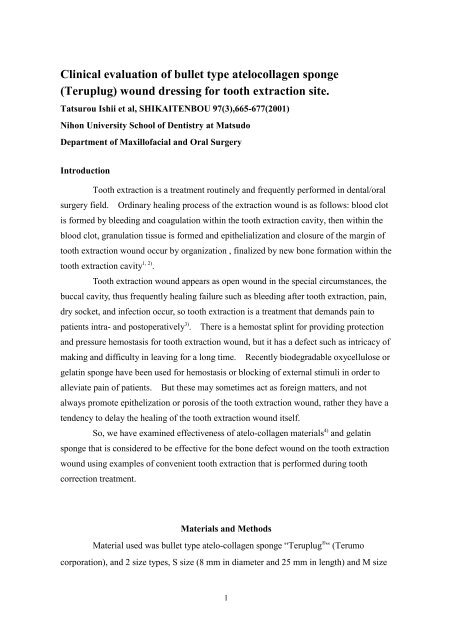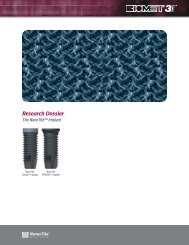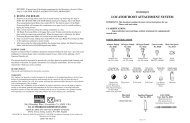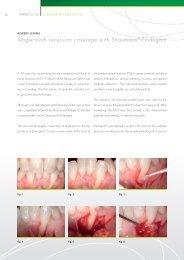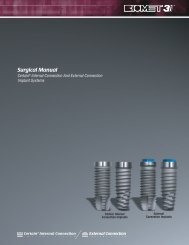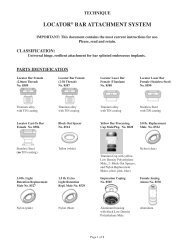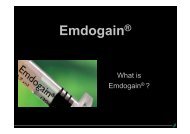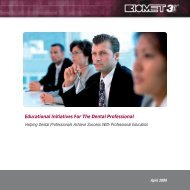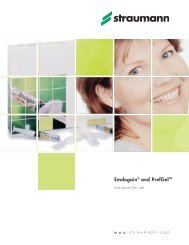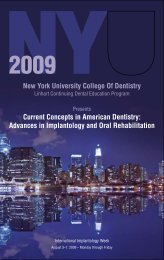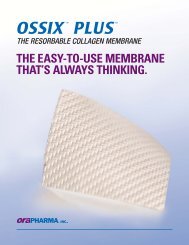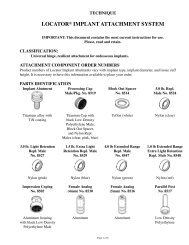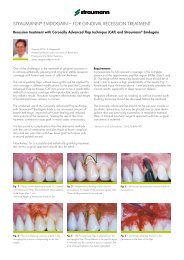(Teruplug) wound dressing for tooth extraction site.
(Teruplug) wound dressing for tooth extraction site.
(Teruplug) wound dressing for tooth extraction site.
Create successful ePaper yourself
Turn your PDF publications into a flip-book with our unique Google optimized e-Paper software.
(1988), provide evidence <strong>for</strong> the significant role of technical analysis, especially incooperation with fundamental analysis (Goodhart, 1988). Studies from Allen andTaylor (1989) and Taylor and Allen (1992), provide evidence <strong>for</strong> the significant roleof technical analysis in <strong>for</strong>eign exchange markets. Allen and Taylor (1989), surveyedmore than 200 bank <strong>for</strong>eign dealers in UK. They demonstrated quite interestingresults showing that bank dealers used different tactics in short, medium, and longterm horizons <strong>for</strong> market <strong>for</strong>ecasting. For the short term horizon, 90% of respondentsused technical analysis, and 60% of them considered technical analysis as importantas fundamental analysis. But as the time horizon increases, this high percentage(90%) starts declining significantly. This result is consistent with Frankel and Froot(1986, 1987, 1990) assertions that the in<strong>for</strong>mation of technical analysis significantlydetermines the short-term equilibrium prices in <strong>for</strong>eign exchange market.Technical analysis has been widely used and influenced perceptions andbehaviours of investors acting <strong>for</strong> other financial markets such as stock market.Shiller (1998) considers technical analysis as a significant factor playing an importantrole <strong>for</strong> the international stock market crash in October 1997. Wong (1993), provideevidence that technical analysis influence investors’ perceptions in Hong Kong stockmarket. The research community has to demonstrate many studies in the field. Forinstance, Black (1986), Campbell and Kyle (1988), and Shleifer and Summers (1990),De Long et al., (1991), contribute to the role of the traders who do not use ormisperceive the fundamentals (noise traders). Additionally, Frankel and Froot(1990a), and Kirman (1991), demonstrate the relationship between fundamental andnon-fundamental approaches. Recent studies (Wong and Cheung, 1999; Lui andMole, 1988) conducted <strong>for</strong> Hong Kong market, provide evidence that analysts in thismarket rely more on fundamental and technical analyses and less on portfolioanalysis. The extend to which either the fundamental analysis or technical analysis areused depends on many factors. For instance, analysts from large firms in Hong Kong,especially those with high positions and high experience, rely more on fundamentalanalysis and less on technical analysis. The oppo<strong>site</strong> result concerns analysts inbrokerage firms where they rely more on technical and less on fundamental analysisand portfolio analysis (Wong and Cheung, 1999). The time horizon also playssignificant role on the implementation of fundamental and technical analyses. Atshorter horizons, technical analysis is more frequent used than fundamental analysis6
Fig. 3 Hemostatic effect immediately after <strong>tooth</strong> <strong>extraction</strong> (case No.7 of Table 1)a: Indication side, b: Control side Indication side was evaluated as “Effective” andthe control side “Blood stained from around.” Further, in the control side, blood flowwas observed along the gingival ridge of the posterior <strong>tooth</strong>.At 1 day after <strong>tooth</strong> <strong>extraction</strong>, all the 25 patients in indication side and all the 26patients in control side were judged as “hemostasis effect was observed” (Table 5).Furthermore, in a comparison between indication side and control side, all the 25 patientswere judged as “the same hemostasis effect” (Table 6).At 1 week after <strong>tooth</strong> <strong>extraction</strong>, all the 26 patients in indication side and all the25 patients in control side were judged as “hemostasis effect was observed” (Table 5).Furthermore, in a comparison between indication side and control side, all the 24 patientswere judged as “the same hemostasis effect” (Table 6).2) Analgesic effectJudgment of analgesic effect immediately after <strong>tooth</strong> <strong>extraction</strong> was done after adisappearance of anesthetic effect, and at 1 day after <strong>tooth</strong> <strong>extraction</strong>, hearing andjudgment were done through interview <strong>for</strong> inquiry. Out of all the 17 patients in theindication side, 13 patients (48 %) were judged as “no pain”, 9 (33 %) were judged as“pain of bearable degree “, and 5 patients (19 %) as “marked pain”. While in the controlside, 8 patients (30 %) were judged as “no pain”, 11 (41 %) were judged as “pain ofbearable degree”, and 8 patients (30 %) as “marked pain” (Table 7). Furthermore, acomparison between indication side and control side revealed that 8 patients (30 %) were8
judged as “indication side had a higher analgesic effect “, 18 (67 %) were judged as “thesame analgesic effect”, and 1 patient (4 %) as “a lower analgesic effect” (Table 8).At 1 day after <strong>tooth</strong> <strong>extraction</strong>, out of all the 26 patients in indication side, 23patients (88 %) were judged as “no pain”, 3 (12 %) were judged as “pain of bearabledegree”, and 0 patients (0 %) as “marked pain”. While out of 27 patients in the controlside, 24 patients (89 %) were judged as “no pain”, 3 (11 %) were judged as “pain ofbearable degree”, and 0 patients (0 %) as “marked pain” (Table 7). Furthermore, acomparison between indication side and control side revealed that all 28 patients (30 %)were judged as “the same analgesic effect” (Table 8). Effect judgment <strong>for</strong> 1 patient whodid not visit clinic was done through interview <strong>for</strong> inquiry at 1 week after <strong>tooth</strong> <strong>extraction</strong>.At 1 week after <strong>tooth</strong> <strong>extraction</strong>, all the 26 patients in indication side and all the25 patients in control side were judged as “no pain” (Table 7). Furthermore, acomparison between indication side and control side revealed that all the 24 patients werejudged as “the same analgesic effect” (Table 8).Table 7 Analgesic effectImmediately after 1 day 1 weekIndicationControl sideIndicationControl sideIndicationControlside (%)(%)side (%)(%)side (%)side (%)A: No pain 13 ( 48) 8 ( 30) 23 ( 88) 24 ( 89) 26 (100) 25 (100)B: Bearable pain 9 ( 33) 11 ( 41) 3 ( 12) 3 ( 11) 0 ( 0) 0 ( 0)C: Marked pain 5 ( 19) 8 ( 30) 0 ( 0) 0 ( 0) 0 ( 0) 0 ( 0)Total 27 (100) 27 (100) 25 (100) i) 27 (100) 26 (100) i) 25 (100) ii)i) One case of drop out is excluded., ii) Two cases of drop out are excluded.Table 8Superiority of <strong>Teruplug</strong> ® in analgesic effectImmediately after (%) 1 day (%) 1 week (%)Better analgesic effect 8 ( 30) 0 ( 0) 0 ( 0)Same analgesic effect 18 ( 67) 26 (100) 24 (100)Poor analgesic effect 1 ( 4) 0 ( 0) 0 ( 0)Total 27 (100) 26 (100) i) 24 (100) ii)i) One case of drop out is excluded., ii) Three cases of drop out are excluded.9
3) Fixation effectJudgment of fixation effect immediately after <strong>tooth</strong> <strong>extraction</strong> was done at about10-15 minutes after <strong>tooth</strong> <strong>extraction</strong>, putting mild pressure and hemostasis. Out of all the27 patients, in both indication side and control side, all were judged as “no dropout”(Table 9). Furthermore, in a comparison between indication side and control side, all the24 patients were judged as “the same fixation effect” (Table 10).At 1 day after <strong>tooth</strong> <strong>extraction</strong>, out of 26 patients in indication side, 25 patients(96 %) were judged as “no dropout”, 0 (0 %) were judged as “partially dropout”, and 1patient (4 %) as “dropped out and its presence is not known” (Fig. 4a). And in thecontrol side, all the 26 patients were judged as “no dropout” (Table 9). Furthermore, acomparison between indication side and control side revealed that out of 26 patients, 0patients (0 %) were judged as “indication side had a higher fixation effect”, 25 (96 %)were judged as “the same fixation effect”, and 1 patient (4 %) as “a lower fixation effect”(Table 10).At 1 week after <strong>tooth</strong> <strong>extraction</strong>, out of all the 27 patients in indication side, 26patients (96 %) were judged as “no dropout”, 0 (0 %) were judged as “partially droppedout”, and 1 patient (4 %) as “dropped out and its presence is not known”. And in thecontrol side, 25 patients (93 %) were judged as “no dropout”, 0 (0 %) were judged as“partially dropped out”, and 2 patient (7 %) as “dropped out and its presence is notknown” (Table 9, Fig. 4b). Furthermore, a comparison between indication side andcontrol side revealed that 2 patients (7 %) were judged as “indication side had a higherfixation effect “, 24 (89 %) were judged as “the same fixation effect”, and 1 patient (4 %)as “a lower fixation effect” (Table 10).10
Table 9 Fixation effectImmediately after 1 day 1 weekIndicationControl sideIndicationControl sideIndicationControlside (%)(%)side (%)(%)side (%)side (%)A: No drop outB: Partially dropout27 (100) 27 (100) 25 ( 96) 26 (100) 26 ( 96) 25 ( 93)0 ( 0) 0 ( 0) 0 ( 0) 0 ( 0) 0 ( 0) 0 ( 0)C: Dropped outand unknown0 ( 0) 0 ( 0) 1 ( 4) 0 ( 0) 1 ( 4) 2 ( 7)where it isTotal 27 (100) 27 (100) 26 (100) i) 26 (100) i) 27 (100) 27 (100)i) One case of no visit is excluded.Table 10Superiority of <strong>Teruplug</strong> ® in fixation effectImmediately after (%) 1 day (%) 1 week (%)Better fixation effect 0 (0) 0 ( 0) 2 ( 7)Same fixation effect 27 (100) 25 ( 96) 24 ( 89)Poor fixation effect 0 (0) 1 ( 4) 1 ( 4)Total 27 (100) 26 (100) i) 27 (100)i) One case of no visit is excluded.Fig. 4Fixation effecta: <strong>Teruplug</strong> ® drop out patient at 1 day after <strong>tooth</strong> <strong>extraction</strong> (case No.15 of Table 1).<strong>Teruplug</strong> ® was dropped out and unknown where it was, while there was blood clotpartially and depression of the <strong>tooth</strong> <strong>extraction</strong> <strong>wound</strong> was found. b: Spongel ® dropout patient at 1 week after <strong>tooth</strong> <strong>extraction</strong> (case No.20 of Table 1). Spongel ® was11
Fig. 5 An extent of epithelization (case No. 26 of Table 1)a: Indication side at 1 day after <strong>tooth</strong> <strong>extraction</strong> b: Its the control side c:Indication side at 1 week after <strong>tooth</strong> <strong>extraction</strong> d: Its the control sideSuperiority of epithelization in the indication side at 1 day and 1 week after <strong>tooth</strong><strong>extraction</strong> was observed.6) Absence or presence of adverse reactionJudgment of absence or presence of adverse reaction was done at 1 week after<strong>tooth</strong> <strong>extraction</strong> and all were judged as “none”. Furthermore, there was no difference ina comparison between indication side and control side (Table 4).7)Superiority of <strong>wound</strong> depressionSuperiority of <strong>wound</strong> depression was judged at 1 week after <strong>tooth</strong> <strong>extraction</strong> bycomparing the degree of depression between indication side and control side. Sixteenpatients (59 %) were judged as “indication side had smaller depression than control side”(Fig.7, 8), 8 (30 %) were judged as “the same depression as control”, and 0 patients (0 %)as “indication side had larger depression than control”. And there were 3 patients (11 %)who were dropout of <strong>Teruplug</strong> ® or Spongel ® and who failed in judgment of superiority14
were categorized as “judgment is impossible due to dropout” (Table 13).Fig. 6 An extent of epithelization (case No. 25 of Table 1)a: Indication side at 1 day after <strong>tooth</strong> <strong>extraction</strong> b: Its the control side c:Indication side at 1 week after <strong>tooth</strong> <strong>extraction</strong> d: Its the control sideSuperiority of epithelization in the indication side at 1 day and 1 week after <strong>tooth</strong><strong>extraction</strong> was observed. Epithelization at “c” showed the tendency ofepithelization from the margin of <strong>tooth</strong> <strong>extraction</strong> cavity and epithelization from<strong>Teruplug</strong> ® at surface of <strong>tooth</strong> <strong>extraction</strong> cavity. Epithelization at “d” only showedepithelization from the margin of <strong>tooth</strong> <strong>extraction</strong> cavity and epithelization tendencyfrom Spongel ® at the surface of <strong>tooth</strong> <strong>extraction</strong> cavity was not observed.15
Fig 7. Superiority of <strong>wound</strong> depression (case No. 6 of Table 1)a: Indication side b: Control side Tooth <strong>extraction</strong> cavity in the control side islargely depressed compared to the indication side.Fig. 8 Superiority of <strong>wound</strong> depression (case No. 14 of Table 1)a: Indication side b: Control side Tooth <strong>extraction</strong> cavity of the control side isdepressed when compared to that in the indication side.Table 13Superiority of <strong>Teruplug</strong> ® in <strong>wound</strong> depression1 week (%)Small depression compared to control 16 (59)The equivalent as control 8 (30)Large depression compared to control 0 (0)Not clear due to drop out 3 (11)Total 27 (100)16
DiscussionCollagen composed of <strong>Teruplug</strong> ® is atelo-collagen, both ends of whose moleculeare digested by pepsin. <strong>Teruplug</strong> ® is produced by mixing fibrillar atelo-collagen (FC)and heat denatured atelo-collagen (HAC), which were produced from the above atelocollagen,with a ratio of 9:1 5) and processed so as to readily fit the <strong>tooth</strong> <strong>extraction</strong> <strong>wound</strong>.On the other hand, Spongel ® is a porous gelatin sponge, which are essentially extractedwith heat using water from hybrid collagen that are obtained by processing bone, skin,ligament, and tendon of animals by acid or alkaline.The purpose of both products include blocking of external stimuli, prevention ofinfection, promotion of epithelialization, promotion of granulation <strong>for</strong>mation, alleviationof pain, and good adhesion just like other <strong>wound</strong> covering materials 5) , but effects varydepending upon each <strong>wound</strong> covering materials. Among these, it is observed that<strong>Teruplug</strong> ® is effective <strong>for</strong> promotion of epithelialization and granulation <strong>for</strong>mation andsuperior in alleviation of pain and leakage prevention of plasma component 6-9) .Normally convenient <strong>tooth</strong> <strong>extraction</strong> is carried out in the premolar. Weselected convenient <strong>tooth</strong> <strong>extraction</strong> as subject of this study as part of correction treatmentbecause the same kinds of teeth of the same jaw can be removed concurrently.Furthermore, with regard to <strong>extraction</strong> <strong>site</strong>, it was expected that there is a technicaldifference in <strong>extraction</strong> of a <strong>tooth</strong> between right and left, so we broke up <strong>Teruplug</strong> ®indication and the control sides to the left and right sides.In this time, as subjects of convenient <strong>tooth</strong> <strong>extraction</strong>, the premolars wereselected and selected <strong>Teruplug</strong> ® were S and M sizes. For indication of <strong>Teruplug</strong> ® , onewith a little bit larger size than that of the margin of <strong>extraction</strong> cavity was selected and itwas pressed or shaped into the morphology to fit the <strong>extraction</strong> cavity, and inserted intothe <strong>extraction</strong> cavity because premolars are simple rooted <strong>tooth</strong> and become thin inproportion to approaching the root apex. However, there was difference of 7 mm indiameter between both sizes, and in some cases, selection of size was difficult.1) With regard to hemostatic effectWith regard to hemostatic effect, as is shown in Table 5, immediately after<strong>extraction</strong>, “Effective” was found in 25 patients (93%) in the indication side, and 20patients (74%) in the control side, “Blood stained from around” was observed in 2 patients17
(7%) in the indication side and 7 patients (26%) in the control side, and “Not effective”was not found in any patient. With regard to superiority of <strong>Teruplug</strong> ® in hemostaticeffect immediately after <strong>tooth</strong> <strong>extraction</strong>, as is shown in Table 6, “Better hemostaticeffect” was found in 6 patients (22%) and “Poor hemostatic effect” in 1 patient (4%).Based on the above, it is considered that <strong>Teruplug</strong> ® has a markedly excellent hemostaticeffect (Fig. 3).<strong>Teruplug</strong> ® is atelo-collagen: its collagen is digested by pepsin, and it is said tohave an excellent hemostatic effect due to platelet aggregation reaction of collagen 7) . Inaddition of these biochemical hemostatic actions, it is said that collagen has physicalaction including holding of hematoma efficiently within collagen sponge 6) , and increasedarea contacting the air within collagen sponge. This may be better hemostatic effect dueto adhesion to the margin of <strong>tooth</strong> <strong>extraction</strong> <strong>wound</strong>, which differs from the effect bypressure from the above just like hemostatic splint.2) With regard to analgesic effectWith analgesic effect, as is shown in Table 7, immediately after <strong>tooth</strong> <strong>extraction</strong>,“No pain” was found in 13 patients (48%) in the indication side and 8 patients (30%) inthe control side. “Bearable pain” was observed in 9 patients (33%) in the indication sideand 11 patients (41%) in the control side, while “Marked pain” was in 5 patients (19%) inthe indication side and 8 patients (30%) in the control side. With regard to superiority of<strong>Teruplug</strong> ® in analgesic effect, as is shown in Table 8, “Better analgesic effect” was foundin 8 patients (30%) and “Poor analgesic effect” in 1 patient (4%). Furthermore, with thepassage of time, immediately after <strong>tooth</strong> <strong>extraction</strong>, at 1 day and 1 week after <strong>tooth</strong><strong>extraction</strong>, effect was changed into “No pain” and “Same analgesic effect.” suggestinglower superiority with time. Based on the above, superiority of <strong>Teruplug</strong> ® in analgesiceffect immediately after <strong>tooth</strong> <strong>extraction</strong> was observed, and good analgesic effect wasobtained. This may be caused by promotion of <strong>wound</strong> healing from earlier stageimmediately after <strong>tooth</strong> <strong>extraction</strong>, in addition to physical covering of the <strong>tooth</strong> <strong>extraction</strong>cavity, blocking of the external stimuli, and increased sealing of the margin just like at thetime of use of hemostatic splint.With administration of analgesic, as is shown in Table 4, among patients whoshowed “Bearable pain” in either the indication side or control side and showed “No pain”in the contralateral side as well as patients who developed “Bearable pain” in both sides,18
there were 4 patients who were administered analgesic, while 6 patients were not. Out ofpatients who developed “Marked pain” in either or both sides, all the 9 patients receivedanalgesic. Analgesic was not administered at 1 day and 1 week after <strong>tooth</strong> <strong>extraction</strong>.The reason why analgesic was administered or not to patients with bearable pain maydepend on the consciousness of patients <strong>for</strong> drug in general and correspondence <strong>for</strong> pain.3) With fixation effectWith fixation effect, as is shown in Table 9, there were 1 completely drop outpatient evaluated as “Dropped out, unknown where it is”, in the indication side at 1 dayafter <strong>extraction</strong> and 2 such patients in the control side at 1 week after <strong>extraction</strong>. Ineither time, drop out patients were less, suggesting superiority in fixation effect.Furthermore, as is shown in Table 10, superiority of <strong>Teruplug</strong> ® was not observed, partlybecause there were less drop out patients. However, fixation effect was largely reducedbecause <strong>Teruplug</strong> ® drop out patients were patients with single rooted <strong>tooth</strong> and patientswith displacement to the palatal side (Fig. 4a).As the method <strong>for</strong> strengthening fixation effect, there are physical characteristicsincluding selection of size or availability to give morphology fitted to the <strong>tooth</strong> <strong>extraction</strong>cavity as well as infiltration of blood by pressing with fingers which is per<strong>for</strong>med at thetime of indication. <strong>Teruplug</strong> ® is a compo<strong>site</strong> made by mixing fibrillar atelo-collagen andheat denatured atelo-collagen with a ratio of 9:1 and has excellent cellular invasivenessand cellular activity, that is, biostability as well as mechanic strength 10) , which maycontribute to good fixation effect.4) Presence or absence of infection after <strong>tooth</strong> <strong>extraction</strong>As is shown in Table 4, infection due to <strong>Teruplug</strong> ® or Spongel ® after <strong>tooth</strong><strong>extraction</strong> was not observed in any patient at 1 day or 1 week after <strong>tooth</strong> <strong>extraction</strong>. Thereason may be that subjects were limited to premolars and only healthy teeth wereextracted. Generally, if infection occurs, removal of applied material, cleaning of <strong>tooth</strong><strong>extraction</strong> <strong>wound</strong>, and gargling of the buccal cavity will be sufficient treatment.5) With regard to epithelizationWith regard to epithelization, as is shown in Table 11, at 1 day after <strong>extraction</strong>19
“Almost completed epithelization” or “About 3/4 epithelization” were not found in anypatient either in the indication side or the control side, while “No epithelization” wasobserved in 11 patients (44%) in the indication side and in 19 patients (73%) in the controlside. At 1 week after <strong>extraction</strong>, either “Almost completed epithelization” or “About 3/4epithelization” was observed in 16 patients (62%) in the indication side and in 8 patients(32%) in the control side, while “No epithelization” was not observed in any patient.With time passage, immediately after <strong>tooth</strong> <strong>extraction</strong>, at 1 day and at 1 week after <strong>tooth</strong><strong>extraction</strong>, increased degree of epithelization was observed. It was also noted that degreeof epithelization was more advanced in the indication side than that in the control side.With regard to superiority of <strong>Teruplug</strong> ® in an extent of epithelization, as is shownin Table 12, at 1 day after <strong>extraction</strong>, “Higher extent of epithelization” was found in 11patients (44%), and “Lower extent of epithelization” was not found in any patient (0%).At 1 week after <strong>tooth</strong> <strong>extraction</strong>, “Higher extent of epithelization” was found in 11patients (46%), and “Lower extent of epithelization” was found in 3 patients (13%). Soit was recognized that either at 1 day or at 1 week after <strong>tooth</strong> <strong>extraction</strong>, <strong>Teruplug</strong> ®indication patients showed higher extent of epithelization (Figs. 5 and 6).Observation of epithelization process <strong>for</strong> both agents was as follows: in<strong>Teruplug</strong> ® indication patients, one-layer granulation tissue was <strong>for</strong>med on <strong>Teruplug</strong> ®surface immediately after <strong>tooth</strong> <strong>extraction</strong>, then it started epithelization, while in Spongel ®indication patients, granulation tissue was not <strong>for</strong>med on Spongel ® surface.Epithelization gradually advanced from the marginal gingiva around the <strong>tooth</strong> <strong>extraction</strong>cavity, then finally the epithelium covers <strong>tooth</strong> <strong>extraction</strong> cavity. In some of <strong>Teruplug</strong> ®indication patients, both epithelization from the margin of <strong>tooth</strong> <strong>extraction</strong> cavity,similarly to Spongel ® indication patients, and epithelization from <strong>Teruplug</strong> ® surface wereobserved. This reason may be as follows: at the time of indication of <strong>Teruplug</strong> ® , if themargin of <strong>Teruplug</strong> ® is indicated with the same level of the marginal gingiva,epithelization from <strong>Teruplug</strong> ® surface will advance, while if the margin of <strong>Teruplug</strong> ® isindicated lower, both epithelization from the margin and epithelization from <strong>Teruplug</strong> ®surface will advance. In all the Spongel ® indication patients, epithelization from themargin advanced, while epithelization from Spongel ® surface was not observed.Generally, healing of <strong>tooth</strong> <strong>extraction</strong> cavity develops from blood clot stage, andadvances to granulation tissue stage, porosis stage, and healing stage. Epithelization ofsurface of <strong>tooth</strong> <strong>extraction</strong> cavity advances concurrently with <strong>for</strong>mation of granulation20
tissue 1, 2) . <strong>Teruplug</strong> ® is excellent in this granulation <strong>for</strong>mation, so in <strong>Teruplug</strong> ® indicationpatients, epithelization may advance comparatively earlier stage, and in Spongel ®indication patients, granulation <strong>for</strong>mation 12) within the <strong>tooth</strong> <strong>extraction</strong> cavity may be slowcompared to that in <strong>Teruplug</strong> ® . Epithelization from the margin develops in advance, soepithelization from the <strong>tooth</strong> <strong>extraction</strong> cavity surface may be delayed when compared tothat in <strong>Teruplug</strong> ® indication patients.6) Presence or absence of adverse reactionPresence or absence of adverse reaction was examined in localized <strong>extraction</strong> <strong>site</strong>at 1 week after <strong>tooth</strong> <strong>extraction</strong> as is shown in Table 4. Both in the indication side andthe control side, all through the period from immediately after <strong>tooth</strong> <strong>extraction</strong> to 1 weekafter <strong>tooth</strong> <strong>extraction</strong>, no patients showed symptoms suggesting adverse reactions. Thus,there are no problems in safety at localized <strong>tooth</strong> <strong>extraction</strong> <strong>site</strong> in either agents.7) With regard to superiority of <strong>wound</strong> depressionSuperiority of <strong>Teruplug</strong> ® in <strong>wound</strong> depression was evaluated at 1 week after<strong>tooth</strong> <strong>extraction</strong>. As is shown in Table 13, “Smaller depression compared to control”was observed in 16 patients (59%) and “Larger depression compared to control” was notobserved in any patient (0%), which indicates superiority of <strong>Teruplug</strong> ® indication patientsin <strong>wound</strong> depression (Figs. 7 and 8).In Spongel ® indication patients, epithelization from Spongel ® surface was notobserved. Epithelization gradually advanced from the marginal gingiva around the <strong>tooth</strong><strong>extraction</strong> cavity, finally epithelium covered the <strong>tooth</strong> <strong>extraction</strong> cavity. These indicatemechanism as follows: Spongel ® surface is exposed <strong>for</strong> a long time, during which itssurface is scraped due to saliva or food debris, and after that epithelization from themargin occurs, which may cause the <strong>wound</strong> depression.Whereas, in <strong>Teruplug</strong> ® indication patients, collagen portion of <strong>Teruplug</strong> ® hassuperiority in cellular invasiveness or cellular activity, that is, biostability 10) so granulationis <strong>for</strong>med on <strong>Teruplug</strong> ® surface in earlier stage and epithelization advances withoutscraping <strong>Teruplug</strong> ® surface, which produces smaller <strong>wound</strong> depression.ConclusionBullet atelo-collagen sponge (<strong>Teruplug</strong> ® ) and gelatin sponge (Spongel ® ) that are21
atelo-collagen materials suggesting effective <strong>for</strong> bone defect were indicated to <strong>tooth</strong><strong>extraction</strong> after convenient <strong>extraction</strong> that is usually per<strong>for</strong>med in correction treatment andits clinical usefulness was compared.Among evaluation variables that were examined this time, <strong>Teruplug</strong> ® showedhigher value in hemostatic effect, analgesic effect, an extent of epithelization of <strong>tooth</strong><strong>extraction</strong> <strong>wound</strong> surface, and <strong>wound</strong> depression when compared with Spongel ® , and itmay be more useful medical material than Spongel ® . Postoperative infection and adversereaction were not found in any patient applied either <strong>Teruplug</strong> ® or Spongel ® locally, thus itwas suggested that both agents may be safe materials, so clinically more useful materialswhen compared to hemostatic splint with complicated operability.22


